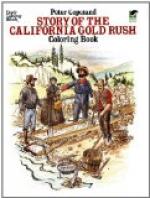When the hot sun had ripened the grain, and all round the white-walled, red-roofed Mission the fields stretched golden and ready for harvest, the Indians cut the wheat, and scattering the bundles over a spot of hard ground, drove oxen round and round on the sheaves till the wheat was threshed out from the straw. Then Indian women winnowed out the chaff and dirt by tossing the grain up in the wind, or from basket to basket, till in this slow way the yellow kernels were made clean and ready to grind.
A curious mill, called an arrastra, ground the grain between two heavy stones. A wooden beam was fastened to the upper stone, and oxen or a mule hitched to this beam turned the stone as they walked round. The first flour-mill worked by water was put up at San Gabriel Mission, and it was thought a wonderful thing indeed.
Even in those early days California wheat was known to be excellent, and many ships came on the South Sea, as they then called the Pacific Ocean, to load with grain for Mexico or Boston or England. Since that time our state has fed countless people, and over a million acres of valley and hill lands are green and golden every year with food for the world. To Europe, to the swarming people of China, Japan, and India, to South Africa and Australia, our grain is carried in great ships and steamers, and hungry nations in many lands look to us for bread.
For a long time after the Mission days, all the grain had to be hauled to the rivers or sea-coast for shipping. Then the overland railroad was finished, and within the next fifteen years an additional two thousand miles of railways were built in California, and nearly every mile opened up rich wheat land that had never been cultivated. Soon great wheat ranches stretched far over the dry, hot valley plains.
The ground is ploughed and seeded after November rains, and all winter the tender blades of grain grow greener and stronger day by day March and April rains strengthen the crop wonderfully, and June and July bring the harvest-time. As no rain falls then, the ripe wheat stands in the field till cut, and afterward in sacks without harm. All the work except ploughing is done by machinery, and this makes the wheat cost less to raise, since a machine does the work of many men and the expense of running it is small.
Some of the ranches have three or four thousand acres in wheat, and it may interest you to know how such large farms are managed. The ploughing is done by a gang-plough, as it is called, which has four steel ploughshares that turn up the ground ten inches deep. Eight horses draw this, and as a seeder is fastened to the plough, and back of the plough a harrow, the horses plough, seed, harrow, and cover up the grain at one time. There the seed-wheat lies tucked up in its warm brown bed till rain and sunshine call out the tiny green spears, and coax them higher and stronger, and the hot sun of June and July ripens the precious grain.




